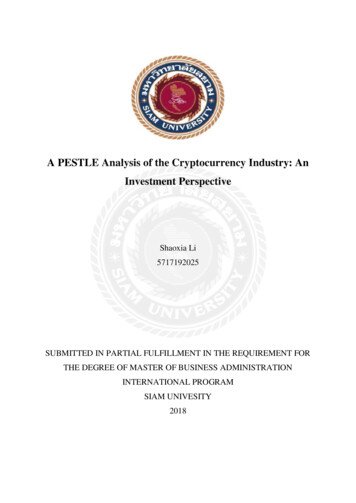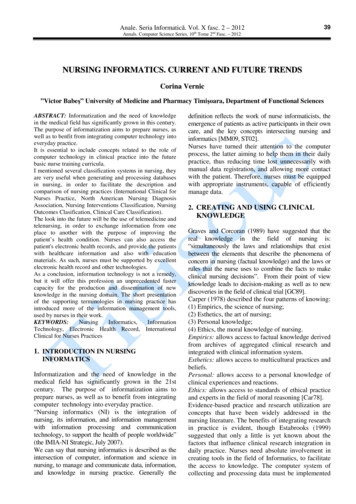
Transcription
The Future of CryptocurrencyAn Investor’s Comparison of Bitcoin and EthereumRyerson UniversityOctober 17th, 2016Alexander D’Alfonso,Peter Langer,Zintis Vandelis
AbstractBitcoin and Ethereum are two highly disruptive cryptocurrencies looking to leverageblockchain technologies to drive innovation across numerous industries. The objectivewas to analyze each cryptocurrency to develop the ideal investment strategy for a 1,000,000 investment which must be held for five years without any additionaltrading.To develop an ideal investment strategy, we analyzed both currencies. After looking atthe qualitative similarities and differences between each currency, we analyzed thehistorical performances of each and extrapolated these values to form a five-yearprojection. Conversations with industry professionals helped to identify the mostprobable and impactful factors for the future demand of both currencies. Afterincorporating our results and accounting for variance, we ran simulations to predict theexpected values given a range of inputs and factors.After weighing these findings, the appropriate investment ratio proved to be 69:31 forBitcoin and Ethereum respectively. Bitcoin offered a higher expected value, but thevolatility and speculative nature of cryptocurrencies indicated a need for diversificationacross platforms.The Future of Cryptocurrency An Investor’s Comparison of Bitcoin and Ethereum Page 1
Table of ContentsAbstract . 1Table of Figures . 3What is Money Anyway? . 4The Investment . 5The Contenders . 5Will History Repeat Itself? . 8Out with the old, In with the New . 9Emerging Market Uptake. 10Financial Institution Uptake. 10Major Regulation / Deregulation . 11Major Network Compromise . 12Global Economic Event (Business Cycle) . 12E-commerce Uptake . 13Financial Technology (‘Fintech’) Uptake. 13Quantitative analysis . 14Investment Strategy . 15Combined Model Results: . 15Conclusion . 16References . 18Appendices . 21The Future of Cryptocurrency An Investor’s Comparison of Bitcoin and Ethereum Page 2
Table of FiguresFigure 1. Comparison of BTC and ETH . 7Figure 2. Sample Likert Survey Scale . 10Figure 3. Monte Carlo Win Rate . 14Figure 4. Final Portfolio Allocation . 16Figure 5. Explanation of Demand Factor weighting . 23Figure 6. Sample Monte Carlo Simulation Results . 24Figure 7. Sample Monte Carlo Time Series . 24Compiled for the 2016 Economist ‘Which MBA?’ Investment Case StudyCompetition, with courtesy to The Economist and Kraken Bitcoin exchange.The Future of Cryptocurrency An Investor’s Comparison of Bitcoin and Ethereum Page 3
What is Money Anyway?Since societies transitioned from a barter economy to using a money as a medium of exchange,individuals have tried to devise systems that allow for rational ways to exchange value. In orderto help make goods and services commensurable the Greek philosopher Aristotle came up withfour criteria that help to dictate what is considered to be ‘good money’ (Lee, 2009):1. It must be durable2. It must be portable3. It must be divisible4. It must have intrinsic valueOriginally the preferred medium of exchange was gold as it was able to fulfill all four of thesecriteria. As economies grew and the demand for a medium of exchange increased, governmentswere forced to create a more accessible medium of exchange that they could control and regulate.This was the birth of fiat currency. This particular medium of exchange has been adoptedworldwide, however it has come with its own set of issues.In order to help fix some of these issues, cryptocurrencies began to emerge in 2009, leveraging adisruptive technology called blockchain. A cryptocurrency is a digital currency that usescryptography for security (Investopedia, 2016). Blockchain specifically deals with the way inwhich data is structured and allows for the existence of decentralized digital ledgers where singleorganizations are not able to effect transactions (Hackett, 2016). Currently the two most widelyadopted cryptocurrencies are Bitcoin and Ether, the currency that is used to power the Ethereumblockchain.The Future of Cryptocurrency An Investor’s Comparison of Bitcoin and Ethereum Page 4
The InvestmentWith the recent rise in popularity of cryptocurrencies many investors are now trying to determinehow to invest into this new asset class. As with any investment into a new technology there aremany factors to consider when assessing their future. In order to make an informed decision onemust look at the origins of the technology as well as the potential applications and limitations inthe foreseeable future.This paper aims to evaluate what the price (in USD) of Bitcoin (BTC) and Ether (ETH) will be inthe next 5 years using thorough quantitative and qualitative analysis. From this evaluation adecision will be made on an appropriate investment allocation between the two currencies for thiscrypto-portfolio.The ContendersBitcoin is the most widely known and used cryptocurrency in the world. The current marketcapitalization of just over 10 billion (USD) (Crypto-Currency Market Capitalizations, 2016).Bitcoin was originally developed by Satoshi Nakamoto as a strictly peer-to-peer electronicpayment system and a solution to the problem of double-spending (Nakamoto, 2008). It isprimarily designed to eliminate the need of financial institutions or ‘trusted third-party’ entities.Bitcoin does this by eliminating the possibility of fraud, increasing efficiencies, and providingobjective proof-of-work to guarantee validity and security in any transaction (Nakamoto, 2008).The use of a public ledger as well as digital signatures allow for a secure and anonymoustransaction without the need for trust, as the public network of nodes validates transactionsthrough finding a consensus among a majority of nodes. Thus far, the primary use cases forBitcoin revolve around increasing efficiencies and eliminating unnecessary time and costs thatThe Future of Cryptocurrency An Investor’s Comparison of Bitcoin and Ethereum Page 5
arrive from using multiple trusted third parties to facilitate transactions (Tapscott, 2016). Bitcoinis highly adoptable in markets that are lacking in traditional financial infrastructure but haveaccess to mobile data, as well as markets with highly inflated currencies that require tools toallow for the mobilization and exchange of currencies (Magee, 2015). Bitcoin’s multiversionconcurrency control is unique and allows for safe concurrent transactions without significantdelay (Greenspan, 2015).Ethereum’s main point of differentiation is the ability to leverage the application of ‘smartcontracts’ within its code. While growing at a much more significant rate over the past year,Ethereum has a total market capitalization of only approximately 10% of Bitcoin (CryptoCurrency Market Capitalizations, 2016). While the underlying currency, Ether, appreciates anddepreciates in value, Ethereum’s value is largely driven by its increased utility and ability toeventually eliminate third parties’ involvement in determining contractual obligations. The mainbenefit of Ethereum can be found in the belief that, as long as it can be coded properly,Ethereum’s smart contracts carry potentially unlimited utility (although, highly complexcontracts could prove to be illogical at this point in time) (Greenspan, 2016). The EthereumNetwork serves to facilitate the exchange of data, information, votes, etc. indicating that there isthe possibility for use cases well beyond simply serving as a disruptor to the current financialinstitutions. The Ether currency serves as the ‘gas’ that powers the transactions within theEthereum Network. Ethereum leverages a Turing-Complete language which could, in theory,solve any computational problem (DeRose, 2016), allowing for an even greater possibility forutility across many areas.The Future of Cryptocurrency An Investor’s Comparison of Bitcoin and Ethereum Page 6
Both Ether and Bitcoin are mined by solving highly complex computational problems.Additionally, as more blocks are mined, the difficulty of finding new blocks increases in bothcases.Comparison: Where Bitcoin currently has a clearly defined use case in which disruption ispossible, the possibilities for Ethereum to enter the market are far less distinct. Ethereum benefitsfrom the possibility of much greater eventual impact. Bitcoin is currently better positioned toleverage and be incorporated into innovations that occur across many industries, whereasEthereum is trying to drive the innovations. Ethereum is at a greater risk of experiencingdisruption, as their network is the major driver of value (while the Ether ‘gas’ simply drives thenetwork). This network which drives innovation opens up Ethereum to be disrupted by futureentrants looking to build upon the existing framework. Bitcoin is largely safe from this threat ofnew entrants as Bitcoin’s explicit purpose of acting as a digital currency has been effectivelyaccomplished, where future innovative networks can use Bitcoin as an underlying asset.Figure 1. Comparison of BTC and ETHBitcoin:Ethereum:Explicit niche, limited range of uses,MVCC, more widely adopted, leveragesinnovationUse of 'smart contracts', versatile,Ethereum Virtual Machine, Turingcomplete, dramatic growth, IoT,innovation driver, blockchain 2.0Shared Traits:Cryptocurrencies, anonymous, no need for ‘trust’, blocks are ‘mined’ with increasingdifficulty, underlying use of blockchain technologyThe Future of Cryptocurrency An Investor’s Comparison of Bitcoin and Ethereum Page 7
Will History Repeat Itself?Using historical data to forecast values of both Bitcoin and Ethereum in five years proved to bevery difficult, as there was insufficient data to project future prices with confidence. Whenexamining the trends in both sets of prices, the 5 year forecast for Bitcoin is 2550 whichrepresents growth of 301%, while Ethereum’s forecasted value is approximately 88, whichrepresents growth of 634%. Both values represent absolutely incredible growth rates due in largepart to the dramatic growth driven by hype and adoption in the early stage of the life cycle.Upon further analysis, the high growth and volatility of both Bitcoin and Ethereum are the resultof news, hype, and speculation. This is shown by the extremely high correlation between pricesand Google searches for each respective currency. When looking at Bitcoin the time-seriescorrelation between price and Google searches for “Bitcoin” is 0.64, while Ethereum’scorrelation is even higher than that, at 0.88. In order to account for the hype in our regressionforecast, the significance of spikes resulting from increased hype and Google searches werediscounted by a factor of 30%. As can be seen in the following figure, prices are significantlydepressed when the hype and speculation surrounding each currency is decreased by 30%. Thedepressed impact of Google searches led to a growth rate for Bitcoin of approximately 300%while Ethereum’s is reduced to 506%. Although the reduced importance of hype and speculationdoes lessen this forecast, Ethereum has clearly experienced more growth in the recent past.The Future of Cryptocurrency An Investor’s Comparison of Bitcoin and Ethereum Page 8
Speculation-Discounted (*) Price Model(BTC on left axis, ETH on right, in USD)8002570020Currency Price6005001540010300200510000BTC CloseBTC Close*ETH CloseETH Close*Note that the (*) values show the weekly closing prices as discounted by search traffic in thatperiod. Although Ethereum appears to be the better investment based on this analysis, past resultsare not indicative of future performance. Additionally, given the highly volatile nature of boththese currencies and the lack of extensive history, this forecast cannot be weighted significantlyin the final decision matrix.Out with the old, In with the NewTo form a strong forward-looking analysis, interviews were arranged with several blockchainexperts as well as one avid cryptocurrency trader. Each of these individuals was polled on theprobability of various ‘macro’ events occurring which might affect the demand for eachcryptocurrency, they were further asked to rate the probable level of impact each event mighthave on the two cryptocurrencies using a 5 point ‘Likert’ scale, shown below in Figure 2.The Future of Cryptocurrency An Investor’s Comparison of Bitcoin and Ethereum Page 9
Figure 2. Sample Likert Survey ScaleEmerging Market UptakeVery LowImpact on BTCImpact on ETHLowMediumHighVery HighXXThe results of this polling are conveyed in the pursuant macro analysis.Emerging Market UptakePotential geographic markets in which cryptocurrencies can beProbability (% estimate)100leveraged include countries with less developed financial infrastructure80BTC(fewer brick and mortar banks), but high smartphone usage. For6040200ETHexample, in Kenya, over half of the national GDP is operated by adigital currency (Magee, 2015). Other countries that have experiencedsignificant devaluation of their national currency could also takeadvantage of efficiencies offered by cryptocurrencies in terms of moving money into and out ofthe country (Magee, 2015). Overall, the potential impact of emerging market uptake is likely tobe more relevant with Bitcoin, which represents the most widely adopted cryptocurrency, withover 14 million Bitcoins in circulation (PricewaterhouseCoopers, 2015) with the highest level ofadoption and lowest level of volatility.Financial Institution UptakeFinancial institutions have shown a willingness to experiment with blockchain technologies todrive operational efficiencies and access previously untapped markets (Torpey, 2015). There hasbeen an unwillingness by large financial institutions to adopt the specific currencies of eitherThe Future of Cryptocurrency An Investor’s Comparison of Bitcoin and Ethereum Page 10
Bitcoin or Ether, as organizations are looking to maintain control ofProbability (% estimate)10080their leger and transaction validation process, something that could be60challenged with the adoption of Bitcoin or Ether (Torpey, 2015). While4020ETHBTCblockchain technology is likely to be adopted by financial institutionsduring the five-year timeline, it is unlikely that either Bitcoin or Ethercurrencies will be widely adopted by major financial institutions.0Major Regulation / DeregulationBitcoin has benefited from largely permissive regulation in westernProbability (% estimate)10080countries, but has been subject to much more restrictions in Asia. The60ban of Bitcoin in China led to a significant depression in Bitcoin prices40200BTC ETHworldwide, indicating the importance of global acceptance toblockchain in order to drive value (Spaven, 2013). Conversely, it hasbeen inferred by numerous sources that in order to achieve widespreadadoption among financial institutions, regulation must be in place to ensure safe and securetransactions (Spaven, 2015). Global deregulation would impact both Bitcoin and Ether, tovarying degrees. Bitcoin, being treated as a currency, would see significant value growth as aresult of deregulation, allowing access into numerous market and ease of transactions acrossborders. While Ether would likely see greater value as a result of widespread adoption andreduction of limitations with the smart contract application. The intrinsic value of a unit of Etherwould not necessarily grow, but the widespread adoption of the Ethereum Network would likelygrow, leading to greater demand for smart contracts and Ethereum.The Future of Cryptocurrency An Investor’s Comparison of Bitcoin and Ethereum Page 11
Major Network CompromiseIn an ecosystem that promotes highly complex and anonymousProbability (% estimate)100exchanges of data, the possibility for major network compromises (i.e.80ETH6040BTC‘hacks’) seems high. The recent example of the DAO attack causing 3.6million individual units of Ether to be siphoned into an alternate DAOindicates the possibility and potential severity of such hacks (Siegel,202016). While the possibility of a ‘51% attack’ in which a majority0stakeholder can significantly impact the value of Bitcoin, the possibility of a major hack isunlikely thanks to the rigid framework of Bitcoin and the relative lack of widespread utility, theonly notable exception being Bitcoin Exchange failures as in the case of the Mt. Gox meltdown.Conversely, Ether has already experienced a significant hack, leading to the fork betweenEthereum and Ethereum Classic. More freedom, more nodes, and more risk is inherent in theEthereum Network, and as such, the risk of a major hack is much higher. There is some risk ofmajor hacks regarding the various exchanges in which both Bitcoin and Ethereum are traded.These hacks while not typically indicative of flaws with the cryptocurrency’s code, havehistorically shown to impact the price of each currency (Nakamura, 2016).Global Economic Event (Business Cycle)Bitcoin has utility strictly as a digital currency. As such, Bitcoin can beProbability (% estimate)10080BTC ETHexpected to have an inverse relationship to the state of the global60economy. Places lacking in financial infrastructure or highly inflated40currencies are more likely to identify Bitcoin as an alternative measure20for transacting (Magee, 2015). Although Ether should also bear an0inverse relationship to the global economy due to these same factors,The Future of Cryptocurrency An Investor’s Comparison of Bitcoin and Ethereum Page 12
the magnitude of this relationship would likely be lessened due to the wide array of uses, and themore innovative nature of the Ethereum Network. Where Bitcoin values are likely to act in thesame manner as commodities, Ether value should relate more closely to widespread adoption ofthe network and smart contracts.E-commerce UptakeThere is potential for e-commerce to positively impact the value ofProbability (% estimate)100ETH80bitcoin as well as ether, however bitcoin is better positioned to be usedin these transactions. The current payment systems are set up such that60BTC40there are multiple touch points which leads to costly transactions (up to2010%) and long processing times (Brennan & Lunn, 2016). Thecryptocurrencies eliminate the need for these verification procedures0and substantially reduce the transaction time. Bitcoin appears specifically useful to minimizethese costs, and while the greater potential for hacks and security issues as a result of complexityfor Ethereum, the likelihood and magnitude of impact would be less significant for Ethereum’sversatile network.Financial Technology (‘Fintech’) UptakeThe blockchain applications for fintech are more favourable for theProbability (% estimate)10080Ethereum platform as it is a more flexible platform for these institutions60to carry out their operations. The benefit that is achieved is a secure40200ETHBTCtransaction as well as a single ledger that reduces the need to reconcileacross each party’s independent ledger (Brennan & Lunn, 2016).Where there could be benefits for the individual currencies is if thefintech companies would like to increase liquidity in low liquidity markets, however this is aThe Future of Cryptocurrency An Investor’s Comparison of Bitcoin and Ethereum Page 13
relatively small opportunity. Due to the wider range of application for the Ethereum smartcontracts, we have inferred that the likely impact of Fintech adoption would be greater forEthereum as they can carry out applications in addition to leveraging the benefits of Bitcoin as acryptocurrency.Quantitative analysisTo compile a quantitative analysis, several simplifying assumptions were made to assist with thecreation of a 5-year predictive model for the price of each cryptocurrency. These assumptionscan be seen in the Appendix.A Monte Carlo simulation was compiled to project the impact of various events occurring withina single time-series simulation. A total of 100 simulations were run to compile an expected returnon each currency after 5 years using a set of four operations to drive the computation. Theseoperations and an example of the simulation can be seen in the Appendix. The results are shownbelow, with Bitcoin outperforming Ethereum in 58 out of 100 simulated worlds. This is due inlarge part to the high variance of outcomes for Ethereum and a wider range of factor probabilitiesdue to a less focused potential use case.Figure 3. Monte Carlo Win RateBitcoin, 58%0%10%20%30%Ethereum, 42%40%50%60%70%80%90%100%The Future of Cryptocurrency An Investor’s Comparison of Bitcoin and Ethereum Page 14
Investment StrategyCombined Model Results:To take into account the various analysis that we performed we have given a weighting to eachanalysis and used this weighting to allocate the funds of the crypto portfolio. The result of theregression analysis are quite positive, though as stated, we need to heavily discount its result inthe overall portfolio decision criteria due to its limitation and has only been given a 5% weight.Due to the forward looking nature of the Monte Carlo analysis and its ability to incorporate amultitude of factors that could potentially play out over the next five years; we have allocated theremaining weight to the results of this analysis. Additionally, to increase the rigor we have comeup with three different sub-criteria for the results of the analysis. The first was to compare each ofthe 100 simulations that were produced to determine which cryptocurrency had a higher expectedreturn and to tally the number of times that each currency had a higher expected return than theother. Since this result shows which currency is more likely to have a higher return over the fiveyear period, we have given this section of the analysis a 40% weight. We also wanted toincorporate an element of risk aversion in the investment decision, therefore we looked at thenumber of times each investment had a negative return over the five-year period. This element ofthe investment criteria was given a 25% weight. Lastly, we wanted to ensure that the portfoliowould be generating a healthy expected return so we took the average of all of the expectedreturns to produce a likely expected return for the duration of the investment. The result of thisevaluation is given a 30% weight. The table below shows the impact each of these weightingshad on the portfolio.The Future of Cryptocurrency An Investor’s Comparison of Bitcoin and Ethereum Page 15
Result – BTCResult – ETHImpact onPortfolio5%300% growthover 5 years506% growth over5 years0% to BTC5% to ETHMonte Carlo –Compared Worlds40%58 (wins)42 (wins)23.5% to BTC16.5% to ETHMonte Carlo –Expected Losses25%38 (losses)46 (losses)15.5% to BTC9.5% to ETHMonte Carlo – AvgExpected Return30%42% (return overthe next 5 years)20% (return overthe next 5 years)30% to BTC0% to ETHAnalysis TypeWeightRegressionTotal100%69% to BTC31% to ETHFigure 4. Final Portfolio AllocationBitcoin, 69%0%10%20%30%40%Ethereum, 31%50%60%70%80%90%100%As seen from the results of the analysis, bitcoin is consistently the better performer however,ether has proven that it should also warrant an allocation of the portfolio. All things considered,we should invest 69% into BTC and 31% into ETH in order to maximize our return over the nextfive years.With this allocation, the expected value of this portfolio after five years is;(𝟏. 𝟒𝟐 𝟎. 𝟔𝟗) (𝟏. 𝟐𝟎 𝟎. 𝟑𝟏) 𝟏𝒎𝒊𝒍𝒍𝒊𝒐𝒏 𝟏, 𝟑𝟓𝟏, 𝟖𝟎𝟎ConclusionWith the advent of blockchain and cryptocurrencies being as new and revolutionary as it is,predicting the five-year projected value of either Bitcoin and Ethereum requires numerous factorsto be considered. Through a combination of qualitative research conducted through interviewswith industry professionals, linear regression, and a Monte Carlo analysis, it can be concludedThe Future of Cryptocurrency An Investor’s Comparison of Bitcoin and Ethereum Page 16
that Bitcoin can leverage its existing user base and proven use case is likely to experience moregrowth in the five-year time horizon. Ethereum, while having a lower expected value has a muchgreater variance as a result of its strong correlation with speculation, news, and hype. Ethereum’swide range of outcomes, both positive and negative, indicate that it should be included in theinvestment portfolio to take advantage of this fact.The Future of Cryptocurrency An Investor’s Comparison of Bitcoin and Ethereum Page 17
ReferencesAgence France-Presse. (2015, July 8). Switzerland begins postal delivery by drone. Retrievedfrom theguardian.com: ed-droneAUVSI. (2014). Connecting the Unmanned Systems Community Across the Globe. Retrievedfrom auvsi.org: http://www.infoag.org/abstract papers/papers/paper 236.pdfAV. (2015). Annual Reports. Retrieved from AVinc.com: http://investor.avinc.com/annuals.cfmCanis, B. (2015). Unmanned Aircraft Systems (UAS): Commercial Outlook for a New Industry .Washington: Congressional Research Office.Carvalho, S. (2015, February 24). Firms see drone sales in Gulf surging after U.S. eases exportpolicy. Retrieved from Reuters.com: sa-drones-idUSL5N0VY2GU20150224Brennan, C., & Lunn, W. (2016, August 3). Blockchain. Retrieved from ds/newsdocs/document-1063851711.pdfClancy, T. (2016, January 20). Ecommerce at Large Coming Around to the Idea of Bitcoin.Retrieved from Cryptocoins News: coming-around-to-the-idea-of-bitcoin/CNBC. (2015). The top Hispanic entrepreneurs in America. Retrieved from ic-entrepreneurs-in-america.html?slide 8Cohen, A. (2015, August 15). Top defense contractors spend millions to get billions. Retrievedfrom Center for Public Integrity: uncil on Foreign Relations. (2015). Global Conflict Tracker. Retrieved from tracker/p32137#!/Dawei, Y. (2015, July 23). The Rise of China’s Drones. Retrieved from /caixin/2015/07/drones in china can the country s industry for uavs bloom.htmlDeloitte & Touche LLP. (2010). Global Aerospace Market Outlook and Forecast.Deloitte. (2014). Global Aerospace and Defense (A&D) Sector. Deloitte Development LLC.Retrieved globalfinancialperformancestudy-infographic.pdfEl Akkad, O., & Cryderman, K. (2014, April 7). Canadian technology and the flight of thedrones. Retrieved from The Globe and ones/article17849259/The Future of Cryptocurrency An Investor’s Comparison of Bitcoin and Ethereum Page 18
Frost & Sullivan. (2013, May 20). Israel is Top Global Exporter of Unmanned Aerial Systemswith a Continued Positive Outlook Ahead. Retrieved fro
cryptocurrency, they were further asked to rate the probable level of impact each event might have on the two cryptocurrencies using a 5











